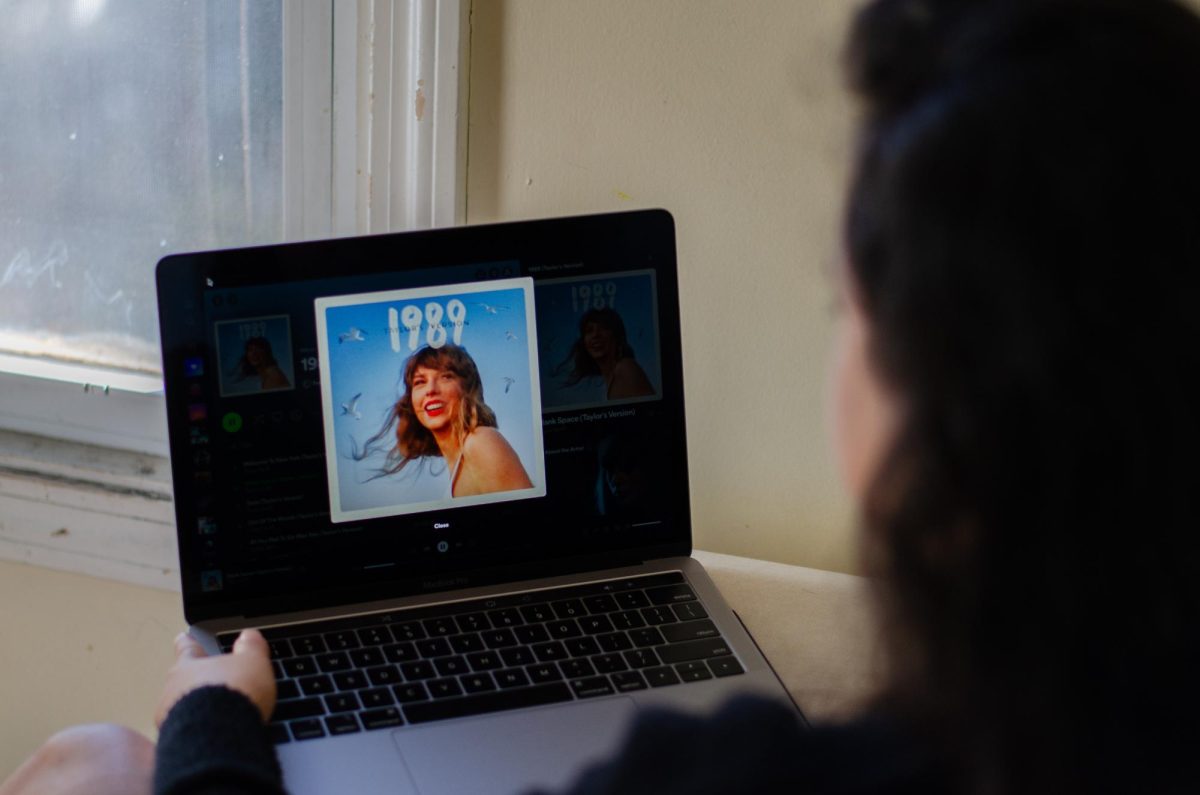“There’s something that I’ve been planning for a really, really, ridiculously, embarrassingly long time,” teased Taylor Swift on Aug. 9, the last night of the North American leg of the Eras Tour in Los Angeles, California. The air at SoFi Stadium rang with the animated screams of fans as each video screen in the stadium faded to reveal the album cover for the re-recording of her breakthrough pop album: “1989 (Taylor’s Version).”
Since the initial announcement, fans have eagerly awaited the arrival of Oct. 27. The significance of this release date was swiftly pinpointed by fans, with Oct. 27 marking the ninth year anniversary of the original “1989,” fitting for the release of one of Miss Americana’s most highly anticipated re-recordings.
Swift has previously teased songs from her re-recording over the past two years with the release of “Wildest Dreams (Taylor’s Version)” and “This Love (Taylor’s Version).”
“Wildest Dreams (Taylor’s Version),” first released in Sept. 2021 as a response to the original version trending on social media platforms like TikTok, retains the dreamy ambience and hypnotizing beats of the original. Meanwhile, Swift’s more pronounced and richer lower timbre is prominent in “This Love (Taylor’s Version),” which debuted in Oct. 2022 in the official teaser trailer for the Amazon Prime television series “The Summer I Turned Pretty.”
With two songs released in advance, there was undeniable excitement among fans for what the entire album would sound like with new instrumentation and vocals.
On the day of Oct. 27, fans were officially welcomed to “1989 (Taylor’s Version)” as pulsing synths and drums created the opening clapping rhythm to “Welcome to New York (Taylor’s Version).”
The album features 21 tracks—the 13 original songs, the three songs “Wonderland (Taylor’s Version),” “You Are In Love (Taylor’s Version)” and “New Romantics (Taylor’s Version)” from the deluxe edition of the original album, and five new, unreleased songs written in 2014.
The instrumentation of songs throughout the re-recording is noticeably much more crisp and sonically processed with modern synths and amplified bass, adding a cleaner quality to the ’80s-style production that pervaded the original. With the production of “1989 (Taylor’s Version),” Swift’s mature vocals are brought to a striking clarity in contrast to the slightly-muffled brightness that her 24-year-old self sang with in “1989.”
In “Shake It Off (Taylor’s Version),” she sings each line with renewed joy, her voice cheekily navigating the notes effortlessly without losing its youthful tone.
“But the monsters turned out to be just trees / When the sun came up you were looking at me,” she vocalizes in “Out of the Woods (Taylor’s Version),” the synthesized chords of the instrumental leading into the climatic bridge of the song. Her delivery of the bridge is powerful, and it is clear that she no longer needs to strain its notes with her refined technique.
She plays with this technique in “I Know Places (Taylor’s Version),” crooning with a new silkiness the lyrics “I can hear them whisper as we pass by / It’s a bad sign, bad sign.” A testament to how her voice has grown, Swift adds a growl at the end of the second pre-chorus, singing out: “And we run.”
The harmonies are especially emphasized in her re-recorded tracks, like in that of her record-breaking hit “Blank Space.” In the original “Blank Space,” the harmonies were obscured by the overpowering instrumental, but the re-recorded version reveals every component of the gorgeous music composition in her songs.
Although many of the songs on the album have been well-received by fans, “Style (Taylor’s Version)” has received mixed opinions regarding the production and tuned vocals. No re-recording will be identical to the originally released album, but there will always be a nostalgia that binds fans to the original “1989” and the fierce, raw emotions Swift embedded within the songs at the time.
When not blinded by nostalgia, it can be easier to recognize the differences between both albums and appreciate each for what they bring. Arguably, “1989 (Taylor’s Version)” has much to be appreciated beyond just being a re-recording, including its “From the Vault” tracks that seem to complete this album as a whole.
Defying fans’ expectations from the provocative title, “‘Slut!’” is a mid-tempo love song that delves into a romantic relationship between Swift and her lover in the spotlight of the media. So content and in love with her partner, Swift accepts her reputation of a “slut” given by the media from her history of ex-lovers, singing breathily over the lush instrumentation, “And if they call me a slut / You know it might be worth it for once.”
“Say Don’t Go” seems to be taken straight off of the original “1989” with its faster tempo and more standard pop chorus that screams the longing that Swift has for her ex-lover to stay and the heartbreak they’ve brought onto her by walking away and leaving her “bleeding.”
In “Now That We Don’t Talk,” Swift demonstrates her control over her falsetto as she mourns the end of a relationship, knowing she no longer holds any importance to her ex-lover after they’ve parted ways. “I cannot be your friend, so I pay the price of what I lost / And what it cost / Now that we don’t talk,” she sings, a relatable feeling for many of her fans who have experienced similar emotions.
With the more metaphor-driven “Suburban Legends,” the understated production allows the song to be centered around Swift as she sings about how her and her lover were “born to be suburban legends,” a destiny that they have fulfilled by the end of the song, though the legacy of their love still remains in the impact on Swift’s life and how it was “ruined.”
Fans have speculated the vault tracks to be about Swift’s short-lived relationship with singer Harry Styles, who she dated between late 2012 and early 2013. The last vault track “Is It Over Now?” seems to confirm this speculation.
This last song concludes the album on a different note than that of the original, with a lingering question left unanswered. Yet, it is not one that needs an answer because life itself does not have all the answers, and that power of the human experience is a theme that Swift explores in her music.
Taylor Swift shows that “1989 (Taylor’s Version)” is meant to be more than just the faithful re-recording of a pop masterpiece. It is an album of healing after heartbreak and pain, and most importantly, it is an album that conveys freedom in every sense of the word.


